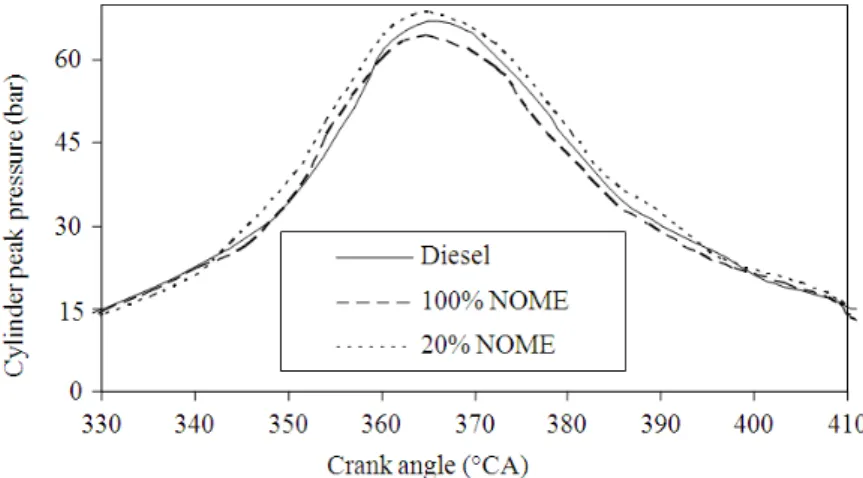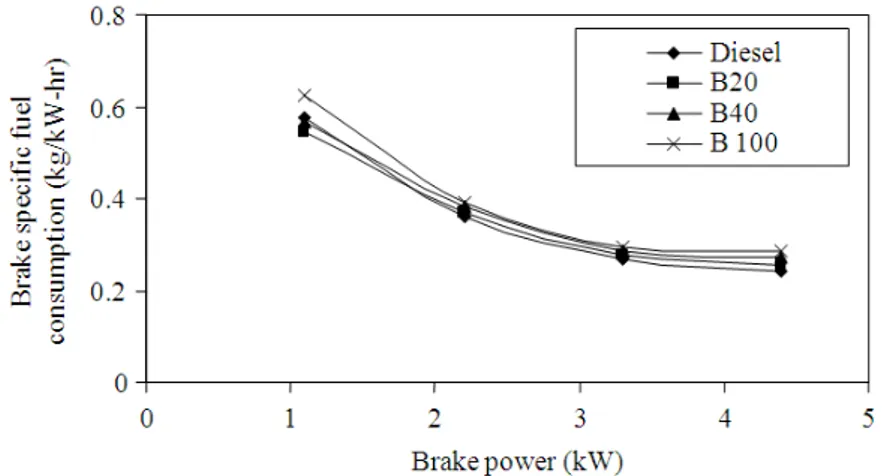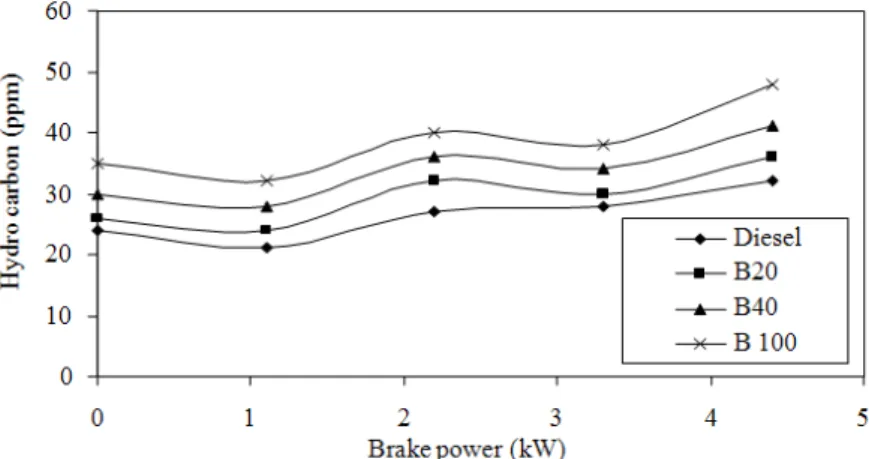©2013 Science Publication
doi:10.3844/ajassp.2013.810.818 Published Online 10 (8) 2013 (http://www.thescipub.com/ajas.toc)
Corresponding Author: L. Prabhu, Sathyabama University, Chennai, India
810
Science Publications AJAS
COMBUSTION, PERFORMANCE AND
EMISSION CHARACTERISTICS OF DIESEL ENGINE
WITH NEEM OIL METHYL ESTER AND ITS DIESEL BLENDS
1
L. Prabhu,
2S. Sathish Kumar,
3M. Prabhahar and
4K. Rajan
1Sathyabama University, Chennai, India 2
St.Joseph’s College of Engineering, Chennai, India
3Aarupadai Veedu Institute of Technology, Chennai, India 4
Dr.MGR Educational Research Institute University, Chennai, India
Received 2013-03-25, Revised 2013-07-02; Accepted 2013-07-09
ABSTRACT
Biodiesel, an alternative fuel is derived from the fats of animals and plants. As energy demands increase and fossil fuels are limited, research is directed towards alternative renewable fuels. The main advantages of using this alternative fuel are its renewability, biodegradability and better quality of exhaust gases. It is technically competitive and environmentally friendly alternative to conventional petro-diesel fuel for use in Compression Ignition (CI) engines. The use of biodiesel reduces the dependence on imported fossil fuels which continue to decrease in availability and affordability. An experimental investigation has been carried out to evaluate the combustion, performance and emission characteristics of a diesel engine with the effect of using neem oil methyl ester and its diesel blends at different loads. The results showed that maximum cylinder pressure and maximum rate of heat release increased with the increase in bio diesel blends. The carbon monoxide (CO) and smoke emissions were found significantly lower when operating on biodiesel-diesel blends, but Nitrogen Oxide (NOx) emissions are found to be higher at full load.
Keywords: Compression Ignition, Diesel Blends, Diesel Engine, Rubber Seed Oil
1. INTRODUCTION
Vegetable oil is one of the alternatives which can be used as fuel for automotive engines either in the form of straight vegetable oil or in the form of methyl ester. The energy needs of the world are increasing rapidly. The decrease in fossil fuels, emission pollution caused by them and increasing fuel prices make biomass energy sources more attractive. The increase in energy demand and decrease in oil reserves have been focused on biofuels. Biodiesel is a fuel that is manufactured from vegetable oils with the help of catalysts and may be directly used in diesel vehicles with little or no modification. The biodiesel is reported to be sulfur-free, nontoxic, biodegradable oxygenated and renewable and the characteristics of biodiesel are very close to diesel fuel (Gerhard, 1983; Murayama, 1984) and some are
lower for biodiesel and it was increased with increase in RBME blends. Pramanik (2003) reported that up to 50% Neem oil could be substituted for diesel for use in a diesel engine without any major operational difficulties. Agarwal (1998) have studied the combustion characteristics of a DI diesel engine with rice bran oil methyl ester and its blends. He reported that the combustion duration and ignition delay increased with vegetable oil compared to diesel. The CO and smoke emissions were decreased while the NOx emissions were increased with increase in blends. Kumar et al. (2003) have studied on a direct injection diesel engine with 30% methanol as duel fuel with Jatropha oil and neat Jatropha methyl esters. Their results showed that the thermal efficiency is improved and smoke emissions and nitric oxides emissions were decreased with duel fuel with 30% methanol and JME blends. The ignition delay was higher for Jatropha oil and it is reduced for Jatropha oil methyl ester.
Geo et al. (2008) have studied the combustion process of Rubber Seed Oil (RSO) and its methyl ester (RSOME) and also reported higher emissions of CO, HC and smoke and lower NOx as compared to that of diesel. Balusamy and Marappan(2008) have experimented with Methyl Ester of Thevetia PeruvianaSeed Oil (METPSO) and reported a lower emission of CO, HC and a higher NOx as compared to that of diesel. Banapurmath et al. (2008) have conducted test with Jatropha, Karanja and Polanga methyl ester in a Diesel engine. They reported that higher peak cylinder pressure and shorter ignition delay for all biodiesels when compared with diesel. Sahoo and Das (2009) have conducted the experiment with methyl esters of Honge (HOME), Jatropha (JOME) and Sesame (SOME) in a single cylinder, four stroke, direct injection Compression Ignition (CI) engine and reported that the higher emission of CO, HC and smoke and lower NO as compared to that of diesel. In this experimental study, the biodiesel from different non-edible oils was produced by a method of alkaline-catalyzed transesterification. Rajan and Kumar (2010) have studied the performance of a diesel engine with internal jet piston using biodiesel. They reported that the brake thermal efficiency is increased; the CO and Smoke emissions are decreased at full load. The NO emission is increased at full load compared to diesel fuel with the base diesel engine. The objectives of this experimental study are to assess the performance, combustion and emission characteristics of a diesel engine with Neem oil methyl ester diesel blends and compared with diesel fuel.
2. MATERIALS AND METHODS
2.1. Biodiesel Preparation
Neem oil was converted into its methyl ester by the transesterification process. This involves making the triglycerides of Jatropha oil to react with methyl alcohol in the presence of catalyst (NaOH/KOH) to produce glycerol and fatty acid ester. Specified amount (1000 mL) of Jatropha oil (450 mL) of methyl alcohol and (10g) of sodium hydroxide were taken in a round bottom flask. The contents were stirred till ester formation began. The mixture was heated to 70°C and held at that temperature with constant speed stirring for 1 hr and then it was allowed to cool overnight without stirring. Two layers were formed. The bottom layer consisted of glycerol and top layer was the ester. The properties of diesel, Neem oil and methyl ester of Neem oil are given in Table 1.
2.2. Test Engine and Experimental Procedure
Experiments have been conducted in a single-cylinder, four-stroke, naturally aspirated, direct injection Diesel engine (Fig. 1). The specification of the engine is given in Table 1. Two separate fuel tanks were used for the diesel fuel and neem oil methyl ester. The volumetric fuel flow rate and the volumetric air flow rate were measured using a 50 cm3 burette/stop watch and a U-tube fuel to flow into the engine. The engine is coupled with an eddy current dynamometer which is used to control the engine torque. Engine speed and load are controlled by varying excitation current to the eddy current dynamometer using dynamometer controller.
Table 1. Properties of diesel, Neem oil and its methyl ester
Properties Diesel Neem oil NOME
Specific gravity 0.83 0.92 0.86
Kinematic Viscosity at 40°C (cSt) 3.72 38.00 4.50
Flash point (°C) 62.00 350.00 152.00
Fire point (°C) 64.00 365.00 180.00
Calorific value (kJ/kg) 42500.00 39500.00 38500.00
Cetane No 48.00 38.00 51.00
Oxygen Content - 12.00% 12.00%
Fig. 1. Schematic of the experimental setup
The engine is operated at the rated speed of 1500 rpm for all the tests. For all the tests, the engine is started with diesel fuel and allowed to stabilize for 30 min. After the engine is warmed up, it is then switched to NOME diesel blends. For each experiment, three measurements are taken to average the data so as to determine the repeatability of the measured data and have an estimate of measured accuracy. At the end of test, the fuel is switched back to diesel and the engine is kept running for a while before shutdown to flush out the NOME diesel blends from the fuel lines and injection system. The performance parameter such as Brake Thermal Efficiency (BTE) and brake Specific Energy Consumption (BSFC), combustion parameters such as cylinder pressure, rate of heat release and emission parameters such as like smoke intensity, HC, CO and NO emissions are measured for diesel fuel and NOME diesel blends. Finally, the test results are analyzed and compared with the diesel fuel.
3. RESULTS AND DISCUSSION
3.1. Combustion Analysis
NOME is 68.6 bar and 64.5 bar respectively, while in the case of diesel, it is 67 bar at full load.
The variation of heat release rate with crank angle at full load is shown in Fig. 3. It is observed that the heat release rate is higher for diesel than 20% NOME and 100% NOME at full load. This may be due to higher volatility and better mixing of diesel with air. Another reason may be, as a consequence of the longer ignition delay, the intensity of premixed combustion phase for diesel is more. On the other hand, the peak heat release rate is lower for 100% NOME compared to 20%NOME and diesel. This may be due to the lower volatility and higher viscosity of NOME, it leads to a reduction in air entrainment and fuel-air mixing rates, resulting in lesser amount of fuel being prepared for premixed combustion stage during ignition delay. It can also be observed the diffusion burning indicated by the area under second peak is dominant for 100% NOME.
3.2. Performance Analysis
The variation of brake thermal efficiency with brake power for diesel and neem biodiesel is shown in Fig. 4. The thermal efficiency is lower for B100 that of B20 and diesel. It may be due to larger differences in viscosity, specific gravity and volatility between diesel and B20. Poor spray formation and reduced spray angle causes reduction in air entrainment and fuel-air mixing rates (Murayama, 1984). The B20 NOME has a lower viscosity, which results in better atomization that leads to complete combustion of the fuel as compared to 100% Neem methyl ester.
Figure 5 shows the variation in brake fuel consumption for diesel and neem biodiesel. The BSFC is an important parameter to evaluate engines performance and determine the fuel efficiency of an engine. The BSFC of diesel engine decreases as the engine brake loads are increased. The brake specific fuel consumption of Neem biodiesel is increased for B20, B100 than that of diesel at full load. It is observed that the BSFC of B20 blends is lower in comparison to neat neem biodiesel. It is observed that the BSFC of B100 is higher than that of diesel fuel when the blends are B20 and B100 are used in diesel engine.
Figure 6 shows the variation of the exhaust gas temperature with brake power for diesel and its biodiesel blends. It can be noticed that the exhaust gas temperature increases with an increase in the load for all the fuels. The exhaust gas temperature for B20, B40 and B100 are 320, 332 and 341°C respectively, whereas for diesel, 302°C at full load. The higher values of the exhaust gas temperature can be attributed to the slow combustion of neem biodiesel compared to diesel fuel. It can also be
observed that the ignition delay is longer for raw Jatropha oil, resulting in slow combustion, which reflects in higher exhaust gas temperatures.
3.3. Emission Analysis
The variation of carbon monoxide (CO) with brake power for diesel and biodiesel blends is presented in Fig. 7. The fuels are producing higher amount of carbon monoxide emission at low power outputs and giving lower values at higher power conditions. Carbon monoxide emission increases at full load for all the fuels. With increasing biodiesel percentage, CO emission level decreases. It can be observed that the CO emissions are lower for B100% as compared to diesel and B20 and B40 and B100 are 0.5% Vol, 0.55% Vol and 0.04% Vol, whereas for diesel, it is 0.55 % Vol at full load. This may be due to relatively poor atomization and lower volatility of NOME blends as compared to diesel. The another reason may also that the biodiesel itself has about 11 % oxygen content in it and it may helps for the complete combustion at full load. Hence, CO emission level decreases with increasing biodiesel percentage in the fuel as compared with the diesel fuel.
The variation of Hydrocarbon (HC) with respect to brake power for diesel and biodiesel blends is presented in Fig. 8. It can be observed that the HC emissions are higher with B100% as compared to diesel and B20 and B40 and B100 are 36ppm, 41ppm and 48 ppm at full load, whereas for diesel it is 32ppm at full load. This increase in HC emission for biodeisel blends may be due to relatively poor atomization and lower volatility of NOME blends as compared to diesel.
The variation of NOxemission with respect to brake
power for diesel and biodiesel blends is presented in Fig. 9. The result shows that the diesel fuel is having lower NO emission and blends of Neem oil are having higher NO emission. Compared to conventional fuel the NO emission is increased by 5% with the blend of Neem oil. The presence of oxygen in NOME helps to produce more amount of NO. The impact of fuel injection also plays a role in the higher NO emissions in the NOME.
Fig. 2. Variation of cylinder pressure with crank angle
Fig. 3. Variation of Heat release rate with crank angle
Fig. 5. Variation of specific fuel consumption with BP
Fig. 6. Variation of exhaust gas temperature with brake power
Fig. 8. Variation of hydro carbon with brake power
Fig. 9. Variation of nitrogen oxide with brake power
Table 2. Test engine specifications
Make Kirloskar, single cylinder
Engine Four stroke, diesel engine
Type Vertical, water cooled engine
Bore Diameter 87.5 mm
Stroke Length 110 mm
Brake Power 4.44 kW
Compression Ratio 17.5:1
Speed 1500 rpm
Fuel injection 23° before TDC
4. CONCLUSION
A single cylinder diesel engine is operated successfully on diesel and NOME diesel blends. The following conclusions are drawn based on the experimental results:
• The BTE and BSFC for 20,40 and 100% NOME are lower than that of diesel fuel at full load
• From the emission analysis it is observed that there is a 10, 15 and 20% increase in NO emission for 20, 40 and 100% NOME at full load as compared to diesel fuel
• The CO emissions are lowered by 23,30 and 40% for 20, 40 and 100% NOME at full load as compared to diesel fuel
• The HC emissions from 20, 40 and 100% NOME blends are increased as compared to that of diesel
• The smoke emissions from 20, 40 and 100% NOME blends decreased by 25 and 33% for at full load
• The peak cylinder pressure for 20% NOME is closer to diesel fuel and it is slightly higher than 100% NOME at full load. The rate of heat release rate during the premixed combustion phase and it is lower for 20% NOME and 100% NOME as compared to diesel
• On the whole, it can be concluded that the performance, combustion and emission characteristics of 20%NOME blend are better compared to 100% NOME. Hence, biodiesel from Neem oil is quite suitable as an alternative to diesel fuel
5. REFERENCES
Agarwal, A.K., 1998. Vegetable oils versus diesel fuel: Development and use of bio-diesel in a compression ignition engine. TERI Inform. Digest Energy, 8: 191-203.
Agarwal, A.K., 2007. Biofuels (alcohols and biodiesel) applications as fuels for internal combustion engines. Prog. Energy Combust. Sci., 33: 233-271. DOI: 10.1016/j.pecs.2006.08.003
Altın, R., C. Selim and H.S. Yucesu, 2001. The potential of using vegetable oil fuels as fuel for diesel engines. Energy Conversion Manage., 42: 529-538. DOI: 10.1016/S0196-8904(00)00080-7
Balusamy, T. and R. Marappan, 2008. Comparative study of thevetia peruviana seed oil with other biofuels and diesel as fuel for CI engine. Int. J. Applied Eng. Res.
Banapurmath, N.R., P.G. Tewaria and R.S. Hosmath, 2008. Performance and emission characteristics of a DI compression ignition engine operated on Honge, Jatropha and sesame oil methyl esters. Renew.
Energy, 33: 1982-1988. DOI:
10.1016/j.renene.2007.11.012
Gattamaneni, L.N.R., S. Saravanan, S. Sampath and K. Rajagopal, 2008. Combustion and emission characteristics of diesel engine fuelled with rice bran oil methyl ester and its diesel blends. Thermal sci., 12: 139-150.
Geo, V.E., G. Nagarajan and B. Nagalingam, 2008. A Comparative combustion analysis of rubber seed oil and its methyl ester in a D.I. diesel engine. SAE Technical Paper.DOI: 10.4271/2008-01-1386 Gerhard, V., 1983. Performance of Vegetable Oils and
their Monoesters as Fuels for Diesel Engines. 1st Edn., Society of Automotive Engineers, Warrendale, pp: 10.
Kegl, B., 2008. Effects of biodiesel on emissions of a bus diesel engine. Bioresour. Technol., 99: 863-873. DOI: 10.1016/j.biortech.2007.01.021
Kumar, M.S., A. Ramesh and B. Nagalingam, 2003. An experimental comparison of methods to use methanol and Jatropha oil in a compression ignition engine. Biomass Bioenergy, 25: 309-318. DOI: 10.1016/S0961-9534(03)00018-7
Murayama, T., 1984. Low Carbon Flower Buildup, Low Smoke and Efficient Diesel Operation with Vegetable Oils by Conversion to Mono-Esters and Blending with Diesel Oil or Alcohols. 1st Edn., Society of Automotive Engineers, Warrendale, pp: 11.
Rajan, K. and K.R.S. Kumar, 2010. Performance and emission characteristics of DI diesel ignition engine with biodiesel using internal jet piston. Environ. Stud.,64: 1982-1988.
Rakopoulos, C.D, K.A. Antonopoulos and D.C. Rakopoulos, 2006. Multi-zone modeling of diesel engine fuel spray development with vegetable oil, bio-diesel or diesel fuels. Energy Conversion
Manage., 47: 1550-1573. DOI:
10.1016/j.enconman.2005.08.005




